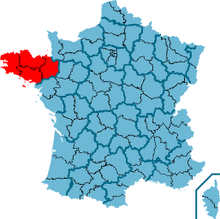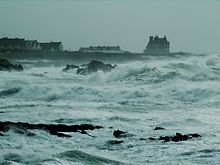



Brittany (French: Bretagne, Breton: Breizh) is a diverse region of northwestern France.
Regions
The region is subdivided into four administrative départements:
Cities
Other destinations
- Carnac - the megalithic menhirs - stones erected by the prehistoric peoples of Brittany
- Lac de Guerledan - artificial lake created by EDF, a scenic highlight of interior Brittany
- Cote d'Emeraude - verdant rocky coast stretching from St Malo to St Brieuc - bustling resorts, charming fishing villages
- Pays de Montfort - Natural and hiking destination between Rennes and the forest of Brocéliande
Breton islands:
Understand

Brittany received its modern name when it was settled (in around 500 AD) by Britons, whom the Anglo-Saxons had driven from Britain. Breton history is one long struggle for independence — first from the Franks (5th–9th century), then the Counts of Anjou and the Dukes of Normandy (10th–12th century), and finally from England and France.
The Breton people maintain a fierce sense of independence to this day, as displayed by their local customs and traditions.
In the past 5 years or so a resurgence of the regional identity has happened in France. Breton art, music and culture are recognized across the nation.
Talk
Being a part of France, French is universally spoken and understood by almost all locals in Brittany. Many people also speak the regional Breton language, a Celtic language more closely related to Scottish Gaelic, Irish and Welsh than to French. While France tried to discourage the use of regional languages, their use is rebounding, bringing a stronger understanding of culture, contributions, and history. Through the local efforts of the Bretons and their DIWAN (Breton language schools), children are being taught in the native language while they learn standard curriculum. The DIWAN schools are supported by worldwide efforts through various groups, including the International Committee for the Defense of the Breton Language.
Due to its proximity to the UK, many people working in the tourism industry can also speak English.
Get in
By ferry
- Channel Islands.
- Jersey and Guernsey to Saint-Malo
- Ireland.
- United Kingdom
- Plymouth to Roscoff and Portsmouth to Saint-Malo
Brittany Ferries operates the following regular services:
- Plymouth-Roscoff (Pont-L'Abbé, Pont-Aven, certain winter sailings operated by Bretagne)
- Poole-Cherbourg (Barfleur, Coutances, Normandie Vitesse (BF trading name for Condor Vitesse)
- Portsmouth-St Malo (Bretagne with winter service operated by Pont-Aven)
- Portsmouth-Ouistreham (Caen) (Mont St Michel, Normandie, Normandie Express, refit cover provided by Bretagne)
- Roscoff-Cork (Pont-Aven, occasionally Bretagne)
By plane
There are airports in:
- Brest (Ryanair flight from London Luton and Dublin, Flybe from Birmingham, Exeter, Manchester, Southampton)
- Dinard (Ryanair flight from London Stansted, and Luton in summer)
- Lannion (Airlinair flight from Paris Orly)
- Lorient
- Quimper
- Rennes (flights from Paris and some other French towns, mainly with Air France)
- Saint-Brieuc (Channel island flights)
The airport in Nantes may also be used along the southern coast or Rennes to/from other European airports and for some transatlantic flights.
By train
The TGV train runs almost hourly from Paris Montparnasse to Rennes, Brest, Quimper and Saint-Malo. SNCF website
Regional trains also link Rennes to Nantes (via Redon) and Saint-Malo or Dinard.
By car
The A11, the Océane Route, links Brittany to Paris. A dual carriageway runs from Rennes to Nantes, and there is a motorway from Nantes to Bordeaux.
By bus
SNCF offers bus services from all major rail stations in Brittany.
Get around
In Brittany, all roads are free (no tolls).
See
- Menhirs and Dolmens Brittany has a large number of megaliths, which simply means "big rocks". These menhirs (standing stones) and dolmens (stone tables) were sites for burials and worship. See some magnificent examples at the bay of Morlaix and the gulf of Morbihan. Museums at Vannes and Carnac detail the archaeological finds made at these sites.
- Gardens Brittany has exceptionally beautiful gardens. See http://en.wikipedia.org/wiki/Remarkable_Gardens_of_France
Do
- Artichaut (ateliers et galerie), Keranheroff, 29690 La Feuillee (Leave La Feuillee on the Berrien road, take the right hand turn by the stone cross), ☏ +33 2 98 99 06 91. 1000–1400, 1200–1800, Tuesday, Wednesday, Thursday, Friday, Saturday and Sunday. Artichaut offers art and craft classes for all ages, from pottery to feltmaking. Suitable for residents and also holidaymakers, for short sessions or all-day courses. Artichaut is also a gallery showing small pieces by Tim and Amanda Bates and other artists. Courses from 6euros per 2hr session to 45euros for full day adult class.
Eat
- Kig ha farz — meat and stuffing
- Coquilles Saint-Jacques
- Oysters — famous in Cancale
- Crêpes and galettes (crêpes made from buckwheat flour) are among the regional specialties
- Tourteaux (large crabs) and spider crabs
- Far breton — cake made with prunes and eggs
- Kouign amann — butter cake, served lukewarm
Drink
- Chouchen — Breton mead, a sweet alcohol made from fermented honey, water and yeast
- Cider — alcoholic drink made from fermented apples. Very good ciders are also found in Normandy
- Beer — there is a great variety (some of them are made with sea water)
- Whisky — There are Breton whiskies. Nevertheless, there are better ones in the Gaelic world...
- Kir Breton — the local adaptation of the kir. You pour Breton cider instead of white wine, preferably from the Rance valley. (Kir, for those uninitiated, is blackcurrant liqueur and white wine.)
Stay safe
When swimming in the sea, watch out for rips and undercurrents. Be mindful that the tide can come at a very fast pace so watch out or you might be stranded on an outlying island! Check the tides (marées) in your local tourist office. Ask for a table of the tides.
Go next
- Channel Islands
- Mont Saint Michel - in Normandie, but very close to the Brittany border; monastery and town built on a tiny outcrop of rock in the sand, which is cut off from the mainland at high tide (and then joined to the continent by a light bridge; cars and buses can no longer pass or park near the Mont, but there's a transport system with light buses). It is one of France's major tourist destinations, and as such gets very busy in high season. Check the times of the tides before you visit!
